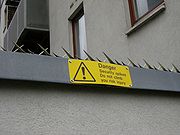Physical security
Physical security describes measures that prevent or deter attackers from accessing a facility, resource, or information stored on physical media. It can be as simple as a locked door or as elaborate as multiple layers of armed guardposts.
Elements and design

The field of security engineering has identified three elements to physical security:
- obstacles, to frustrate trivial attackers and delay serious ones;
- alarms, security lighting, security guard patrols or closed-circuit television cameras, to make it likely that attacks will be noticed; and
- security response, to repel, catch or frustrate attackers when an attack is detected.
In a well designed system, these features must complement each other. There are four layers of physical security:
- Environmental design
- Mechanical and electronic access control
- Intrusion detection
- Video monitoring
The initial layer of security for a campus, building, office, or physical space uses environmental design to deter threats. Some of the most common examples are also the most basic - barbed wire, warning signs and fencing, concrete bollards, metal barriers, vehicle height-restrictors, site lighting and trenches.

The next layer is mechanical and includes gates, doors, and locks. Key control of the locks becomes a problem with large user populations and any user turnover. Keys quickly become unmanageable forcing the adoption of electronic access control. Electronic access control easily manages large user populations, controlling for user lifecycles times, dates, and individual access points. For example a user's access rights could allow access from 0700 to 1900 Monday through Friday and expires in 90 days.
The third layer is intrusion detection systems or alarms. Intrusion detection monitors for attacks. It is less a preventative measure and more of a response measure, although some would argue that it is a deterrent. Intrusion detection has a high incidence of false alarms. In many jurisdictions, law enforcement will not respond to alarms from intrusion detection systems.

The last layer is video monitoring systems. Like intrusion detection, these are not much of a deterrent. Video monitoring systems are more useful for incident verification and historical analysis. For instance, if alarms are being generated and there is a camera in place, the camera could be viewed to verify the alarms. In instances when an attack has already occurred and a camera is in place at the point of attack, the recorded video can be reviewed. Although the term closed-circuit television (CCTV) is common, it is quickly becoming outdated as more video systems lose the closed circuit for signal transmission and are instead transmitting on computer networks. Advances in information technology are transforming video monitoring into video analysis. For instance, once an image is digitized it can become data that sophisticated algorithms can act upon. As the speed and accuracy of automated analysis increases, the video system could move from a monitoring system to an intrusion detection system or access control system. It is not a stretch to imagine a video camera inputting data to a processor that outputs to a door lock. Instead of using some kind of key, whether mechanical or electrical, a person's visage is the key.

Intertwined in these four layers are people. Guards have a role in all layers, in the first as patrols and at checkpoints. In the second to administer electronic access control. In the third to respond to alarms. And in the fourth to monitor and analyze video. Users obviously have a role also by questioning and reporting suspicious people. Aiding in identifying people as known versus unknown are identification systems. Often photo ID badges are used and are frequently coupled to the electronic access control system. Visitors are often required to wear a visitor badge.
For example, the response force must be able to arrive on site in less time than it is expected that the attacker will require to breach the barriers; and
- persuading them that the likely costs of attack exceed the value of making the attack.
For example, ATMs (cash dispensers) are protected, not by making them invulnerable, but by spoiling the money inside when they are attacked. Attackers quickly learned that it was futile to steal or break into an ATM if all they got was worthless money covered in dye.
Conversely, safes are rated in terms of the time in minutes which a skilled, well equipped safe-breaker is expected to require to open the safe. These ratings are developed by highly skilled safe breakers employed by insurance agencies, such as Underwriters Laboratories. In a properly designed system, either the time between inspections by a patrolling guard should be less than that time, or an alarm response force should be able to reach it in less than that time.
Hiding the resources, or hiding the fact that resources are valuable, is also often a good idea as it will reduce the exposure to opponents and will cause further delays during an attack, but should not be relied upon as a principal means of ensuring security (see security through obscurity and inside job).



No comments:
Post a Comment